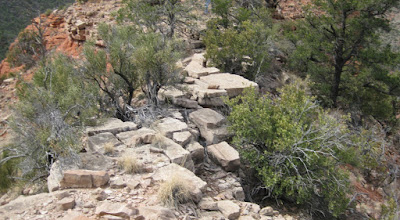 |
Left to right: Jim Manning, Dolly Yapp, Gordon Bice and George Everman - Photographer: Ellis Price
|
We paused to admire some soap tree yucca plants along the way. Although we were attracted at first by a small, perfectly formed sample of the plant alongside the trail, I was more intrigued by a group of more mature plants framing a hillside topped with a red rock bluff.
 |
Perfectly formed soap tree yucca Soap tree yucca plants framing
hillside view
|
 |
Our goal is pointed out by a faint vapor trail on the horizon in the center of this photograph.
|
 |
Cairn marking the spot where the trail makes a sharp right turn.
|
 |
Snack break Going where no trail exists
|
 |
Paper-spined fishhook cactus Prickly Pear Cactus with a skirt
(endangered in AZ)
|
 |
Shot of the saddle between the mountain proper and the red butte
|
Less than a tenth of a mile beyond the saddle leading to the butte, we arrived at the Indian ruins.
 |
View of Indian ruins
|
Just past the ruins, I found a place where one could easily climb on up the cliff to the plateau above the ruins (below left). I paused about half way up to take a shot of hikers standing in front of the ruins (below right).
 |
An easy (relatively speaking) path Looking back at the hikers in front
to the top of the ruins
|
From the ruins, and
especially from the plateau above, one is afforded spectacular views
across Sedona and the surrounding red rock country. See the two
following photographs as examples.
 |
View of red rock country
|
 |
View of red rock country
|
After I climbed down
from the plateau above and we had finished with the ruins, we turned
our attention to our next objective … the red butte with the cave
running all the way thru. The butte was clearly visible from the
ruins and we made our way back along the mountainside until we
arrived at the saddle that crosses over to it.
 |
Red butte from the Indian ruins Crossing the saddle to the red butte
|
After
crossing the saddle it was just a few yards to the cave opening. The
opening, at the very bottom of a seam in the butte, did indeed go all
the way through, a distance of about 35 feet. After some discussion
of technique, George climbed through the butte and took a picture
from the other side. The below pictures show the opening through the
butte, a picture from the other side, George stopping for a photo on
the way back and George emerging from the opening.
 |
Looking through the butte (south to Picture from the opposite (north) north) opening
|
 |
George starting the trip back through George emerging from the cave
the cave in the red butte
|
 |
Left to right: Ellis (behind the brush), Gordon, Jim and Dolly (George was the photographer)
|
When we arrived back at the parking area, my GPS showed that we had hiked 8.2 miles and that the elevation gain was around 600 feet.
The GPS Track for this hike is shown included map (below)

No comments:
Post a Comment